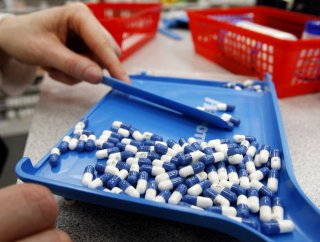Why the Drug Supply Is Still Mostly Secure Despite the Coronavirus
A good thing too.
The nationwide shutdowns of Chinese business activity seen in February, followed by Indian Prime Minister Narendra Modi’s announcement of a month-long nationwide lockdown on March 27, have raised alarms about the potential cutoff of critically important drugs sourced from those two countries due to the COVID-19 pandemic.
- Both India and China are extremely important in terms of market share, in particular for low-cost generic drugs, which make up 90 percent of U.S. prescriptions.
- China is the second-largest exporter of finished drugs to the United States, but it also is by far the largest source of Active Pharmaceutical Ingredients (APIs), with an 80 percent market share.
- India, meanwhile, supplies about 40 percent of the generic and over-the-counter drugs used in the United States (though around 70 percent of that Indian supply relies on APIs sourced from China).
These pharmaceutical supplies would be extremely difficult for countries such as the United States to replace in the short term. At best, it would take 6-12 months to set up alternate manufacturing facilities, and the U.S. Food and Drug Administration would then have to certify each new facility. The vulnerability is real, as the impact on U.S. public health of widespread pharmaceutical supply cutoffs would be profound, which has spurred some U.S. legislators to push for the "reshoring" of these supply chains.
The Resilience of Pharmaceutical Supply Chains
Despite the level of import dependency, however, U.S. pharmaceutical companies’ supply chains from Asia are proving highly resilient during the current crisis.
U.S. Reshoring Efforts
Given the resilience the pharmaceutical supply chain has so far shown, even with the heavy reliance on Chinese sourcing, it will be difficult for proponents of “reshoring” efforts in the United States to offset the clear cost advantages. Both the U.S. Senate and the House of Representatives recently introduced two separate pieces of legislation that would effectively force U.S. companies to source pharmaceuticals outside of China. The proposed Senate bill, in particular, would completely bar the use of federal funds to pay for Chinese-origin drugs. The U.S. pharmaceutical industry is almost unanimously opposed to both these bills, however. And countervailing bipartisan pressures to rein in health care costs in the United States — combined with the fact that COVID-19 has yet to cause widespread disruptions to U.S. drug supply — will push strongly against such import restrictions.
- This is, in part, due to the reported decrease in the number of new cases of COVID-19 in China, which allowed the bulk of Chinese pharmaceutical manufacturing capacity to be restored to at least partial operation in March. Even in Wuhan, the epicenter of the initial outbreak, the Chinese API maker and pharmaceutical company WuXi AppTec reported that its manufacturing plant was back to normal operations on March 12. The U.S. drugmaker Eli Lilly also reported that all of its Chinese-sourced inputs were back in production, including insulins, on March 9.
- Unlike most industries, the pharmaceutical sector also operates on longer timelines, making it less vulnerable to short and sudden supply chain disruptions. Recent data released by the U.S. consulting firm McKinsey & Company put the time-to-stock depletion from foreign supply disruptions at 8-11 months for the industry.
- Export controls under India’s new lockdown measures have yet to be broadly adopted (other than a ban on exports of hydroxychloroquine, which has been touted by some as potential COVID-19 therapies). Mylan Pharmaceuticals, the largest U.S.-based manufacturer of generic drugs, stated on March 26 that its operations in India and supplies to the U.S. market have not been impacted by New Delhi’s new lockdown measures. Since most Chinese API supplies are being restored, concerns about the availability of drugs for India’s own domestic market may also abate. In addition, the administration of U.S. President Donald Trump has also begun talks with India about continuing supplies to the United States.
- The only supply chain problems that have emerged in recent days relate to a small number of drugs that have seen demand spikes as a result of COVID-19, rather than problems originating with foreign suppliers. The main problems involve drugs used for intubations (namely pain relievers such as fentanyl and paralytics), as well as chloroquine and hydroxychloroquine.
- Airfreight carriers have continued to operate despite restrictions on international travel as well, so this is not an impediment to supply chain continuity. Total freight capacity is down and rates are up substantially, given that some of the capacity normally available is in the cargo holds of passenger aircraft. This, however, is a minor cost for pharmaceutical and APIs companies due to the low weight-to-value ratio of their products.
Image: Reuters.

